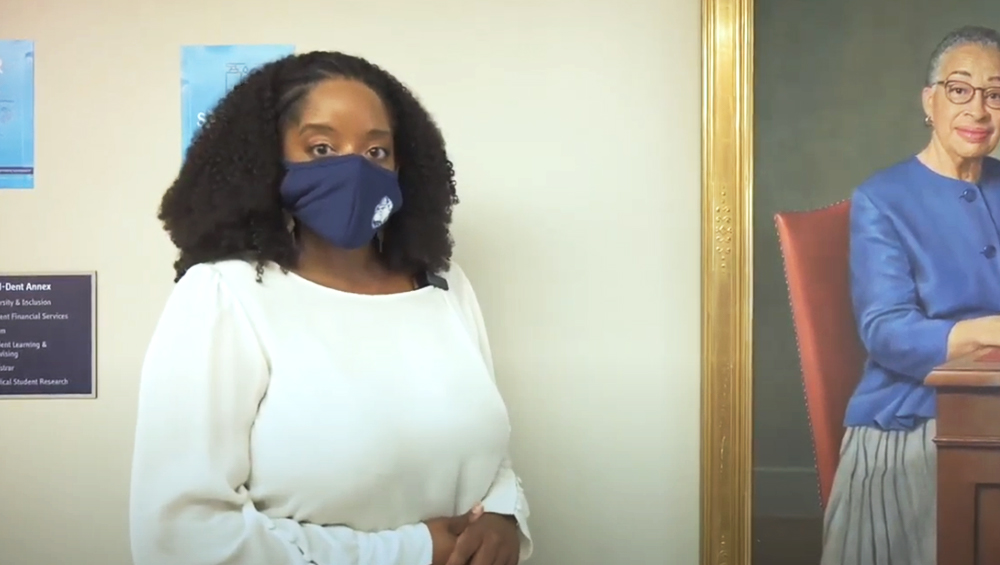New Diversity, Equity and Inclusion Longitudinal Track Prepares Medical Students for Leadership Roles

Posted in GUMC Stories | Tagged diversity, health equity, inclusion, medical education, racial equity, School of Medicine
(October 8, 2021) — As a School of Medicine student on the medical education research scholar longitudinal track, L. Tamara Wilson (M’21) expected that she’d simply submit her capstone project — a proposal for a new track in diversity, equity and inclusion in medicine — then work toward implementing it at another institution after she graduated.
“I honestly, at the time, thought I was not going to be able to get this accomplished at Georgetown,” said Wilson, now a first-year resident in emergency medicine at Baylor College of Medicine in Houston. “But Georgetown was really supportive of the track, and so many people wanted it and were able to give it institutional support.”
After being vetted by the relevant subcommittees, Wilson’s proposal was enthusiastically approved by the School of Medicine’s Committee on Medical Education. Launching this fall, first-year medical students may apply to participate in the new longitudinal academic track in diversity, equity and inclusion in medicine, one of seven optional longitudinal tracks currently offered by the School of Medicine.
The new longitudinal track will require students to complete foundational modules and leadership training in diversity, equity and inclusion, 50 hours of experiential learning, immersive coaching with senior leaders in the field, student mentoring and a capstone project.
While she’s excited to see what happens with the new track, Wilson expressed disappointment that she’s unable to see it blossom firsthand. “I really want to still keep one ear to the program to see how we’re able to cultivate these interests in Georgetown students,” she said. “It’s kind of bittersweet to leave and see this happen.”
Planning the Program
When Wilson started thinking about developing a longitudinal track in diversity, equity and inclusion, she researched to see if other medical schools offered something similar, such as a minor or concentration on the topic. She found some programs for those approaching the topic from a human resources perspective, but very few programs for medical students.
“I think that’s the whole point of the medical education track, to address issues that you see in education,” she said. “At the time, there weren’t very many places that had this up and going, so I just continued putting together the program.”

More academic medical institutions are interested in hiring people with the type of expertise in diversity, equity and inclusion that students will develop by participating in the new longitudinal track, said Colin Stewart, MD, associate professor of clinical psychiatry and longitudinal track co-director. “She really had some forethought, given that it’s become pretty clear within academic medical institutions that they need to have leaders focused on DEI issues.”
For her capstone proposal, Wilson completed an extensive literature review and market analysis demonstrating the need for the track. She also organized focus groups with students, faculty, administrators and outside consultants, including David Acosta, MD, of the AAMC and Bonnie Mason, MD, of the ACGME, sharing the draft curriculum with participants and asking whether any elements should be added or removed.
Wilson expressed gratitude to Rebecca Evangelista, MD, associate dean for clinical faculty, Carrie Chen, MD, PhD, associate dean for assessment and educational scholarship, and Susan Cheng, EdLD, MPP, senior associate dean for diversity and inclusion, for their support and feedback. “They were my DEI mentors and academic mentors in pulling this thing together,” she said.
Experiential Learning
Medical students on the longitudinal track in diversity, equity and inclusion will start by taking foundational modules and leadership training on topics including anti-racism, cultural humility and overcoming bias. Students will also participate in experiential learning, working with a community-based organization to address a need related to diversity, equity and inclusion.
Additionally, students will receive coaching from senior leaders in diversity, equity and inclusion and serve as mentors for pipeline programs offered by the Office of Diversity, Equity and Inclusion, such as the Gateway Exploration Program (GEP) and the Cultivating Opportunity & Realizing Excellence (CORE) Leadership Program.
The students’ work on the longitudinal track will culminate in a scholarly capstone project addressing an issue in medicine related to diversity, equity and inclusion, with a poster presentation, abstract or manuscript submission, program design or evaluation, or equivalent deliverable. Students may draw from their experiential learning with a community-based organization for their capstone.
Sample capstone projects may involve supporting organizations with a workplace equity assessment, surveying whether patients feel respected in clinical encounters, creating interventions that promote anti-racism strategies within organizations or developing suggestions to increase diversity in an organization’s workforce. “To me, as long as it’s promoting diversity, equity and inclusion in the medical space, the project is going to get the green light,” Stewart said.
All Hands on Deck
Early on in the process, Wilson started trying to identify faculty members who could serve as co-directors for the longitudinal track. “I recognize that in graduating, I had to find people that would be interested in keeping it alive,” which led her to Stewart and Ann Jay, MD, associate professor of clinical radiology and otolaryngology.

“Originally, I looked to underrepresented faculty and administrators to lead the track but soon found that several leaders in this space were taxed with so many responsibilities that they did not have the bandwidth to take it on,” Wilson said. That said, the work to improve diversity, equity and inclusion in medicine shouldn’t fall exclusively on the shoulders of those who are underrepresented in the field, she added.
“Dr. Stewart and I are hoping that we are able to execute Tamara’s vision for this track,” said Jay, longitudinal track co-director. “Part of that vision is creating a deliberate and purposeful leadership pipeline to mentor the next co-directors, who will be URIM [underrepresented in medicine] faculty. It was written into the blueprint that Dr. Stewart and I will pass on directorship once the track is up and running successfully.”
Empowering medical students with an interest in diversity, equity and inclusion, regardless of their backgrounds, is a goal for the longitudinal track. “We’re not going to be looking for the people with the best grades or who came from the fanciest school,” Stewart said. “We’re going to be looking for the people who have the most passion for this kind of work and people who have lived experiences that help them really connect with the people they will be serving through these leadership roles.”
“The ideal student would want to engage in the topics and create change in the future, whether that’s in their own private practice, academia, or a medical center or health institution in the future,” Wilson said. “I can’t underscore enough how we all need to be engaged, all specialties, all backgrounds, engaged in these topics.”
A Rare Opportunity
Having a longitudinal track in diversity, equity and inclusion will give medical students an overview of the relevant topics in the area and the opportunity to explore some of those topics in depth.
“DEI is a very broad field with important subtopics,” Wilson said. “It [the longitudinal track] will give people a base in DEI topics, and then a more focused experience in several topics. And people will be able to design their own DEI intervention to improve a challenge within the DEI space.”
Promoting the DEI longitudinal track demonstrates that educating future health care providers on diversity, equity and inclusion is one of Georgetown’s priorities, Jay said. “It’s not just about checking off a box,” she said. “The goal is to educate students to be leaders in the DEI space so that the ripple effect from their training can continue forward, far beyond their time at the School of Medicine.”
Participating in the diversity, equity and inclusion longitudinal track will demonstrate students’ dedication to the subject to future residency programs and employers, and help applicants identify organizations that really value diversity. “If you’re interested and passionate in DEI and you have this on your CV, you’re going to be self-selecting for programs that have DEI in their mission or vision or part of their program,” Wilson said.
“I would say this is a program within Georgetown that is innovative and at the forefront,” Stewart said.
Kat Zambon
GUMC Communications
